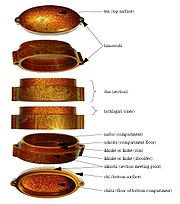
Inro
Encyclopedia

Obi (sash)
is a sash for traditional Japanese dress, keikogi worn for Japanese martial arts, and a part of kimono outfits.The obi for men's kimono is rather narrow, wide at most, but a woman's formal obi can be wide and more than long. Nowadays, a woman's wide and decorative obi does not keep the kimono...
, or sash. Most types of these sagemono were created for specialized contents, such as tobacco, pipes, writing brush and ink, but inrō were suited for carrying anything small. Consisting of a stack of tiny, nested boxes, inrō were most commonly used to carry identity seals and medicines. The stack of boxes is held together by a cord that runs through cord runners down one side, under the bottom, and up the opposite side. The ends of the cord are secured to a netsuke
Netsuke
Netsuke are miniature sculptures that were invented in 17th-century Japan to serve a practical function...
, a kind of toggle that is passed between the sash and pants and then hooked over the top of the sash to suspend the inrō. An ojime
Ojime
' are a type of bead which originated in Japan. They were worn between the inro and netsuke and are typically under an inch in length. Each is carved into a particular shape and image, similar to the netsuke, though smaller....
is provided on the cord between the inrō and netsuke to hold the boxes together. This is a bead with a hole through the center through which the cord is passed. It is slid down to the top of the inrō to hold the stack together while the inrō is worn, and slid up next to the netsuke when the boxes need to be unstacked to access their contents. Inrō were made of a variety of materials, including wood, ivory, bone, and lacquer. Lacquer was also used to decorate inro made of other materials.
Inrō, like the ojime
Ojime
' are a type of bead which originated in Japan. They were worn between the inro and netsuke and are typically under an inch in length. Each is carved into a particular shape and image, similar to the netsuke, though smaller....
and netsuke
Netsuke
Netsuke are miniature sculptures that were invented in 17th-century Japan to serve a practical function...
they were associated with, evolved over time from strictly utilitarian articles into objects of high art and immense craftsmanship.

